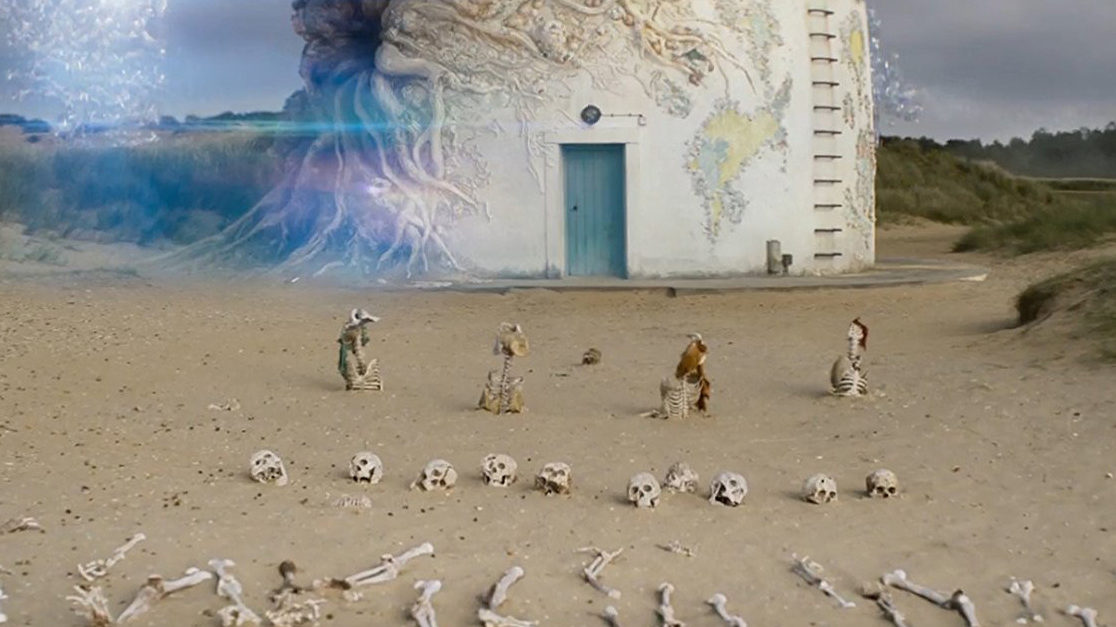Enfolding Each Other
Simone Hutchinson
If ecology is an approach [rather than a discipline], it proceeds from questions about viewing, subjects and objects. [i]
[The] irresistible attraction toward enfolding each other is the vital motor of living and dying on earth. [ii]
Ecology is best thought of as an approach which attempts to understand a dynamic relationship rather than as a study of physical structures [iii]. Anthropocene is ecology’s name for the current geological Era, but the word also encapsulates the single most important relation of our time: that between humankind and the environment. For that reason, essays on the Anthropocene may be found in disciplines far from ecology, such as art and literature. A Marxist articulation of the Anthropocene claims that ‘androgenic climate change is an unintended consequence of collective human labour’ [iv]. This statement implicates our socio-economic history in the degradation of the environment and emphasises the destructive potential of the economy when its power is prioritised over other socio-political concerns.
 Annihilation, 2018. Photo: Paramount Pictures.
Annihilation, 2018. Photo: Paramount Pictures.
Ecological criticism has joined other left-positioned political discourses in challenging the presumed naturalness of capitalism’s supremacy. Anti-racist, anti-ableist, LBGTQIA, intersectional feminist and now ecological conceptual frameworks share in common their different but intersecting quests to resist capitalism and deconstruct the human body (of one kind or another). These contemporary critical approaches to ideas about the human being in its social and ecological contexts draw from postmodernist theories of subjectivity and language. Language is important for ecology, which is ‘a verbal study of the oikos and a genre of scientifically and sociologically descriptive writing’ [v]. Postmodernist discourses work well with ecocritical ones in providing a new conceptual language for imagining a fairer world beyond capitalism, since they both place the human in liminal regions amid psycho-social or geographical landscapes, where the human subject’s ecologically privileged position is disappeared, and where its de-centred position takes on new resonances.
Science fiction writer M. John Harrison populates his Kefahuchi Tract trilogy (Light, Nova Swing, and Empty Space: A Haunting) with de-centred subjects whose importance to the unfolding events taking place in their universe is incidental. Neither characters nor plots are singly important, making each novel in the trilogy barely whole, comprised of countless fragments. The trilogy’s universe is ruled by complementarity – a physics where problems are resolved not by one law alone but by multiple. In this trilogy, aliens discover space travel technology one way, while humans find it out by another. Different methods arrive at the same result. This idea should be revolutionary, not least because such a system accepts difference.
This is the only positive, hopeful element of this trilogy. The future it presents is shabby and retrospectively hooked on twentieth-century kitsch. The inclusion of a place called the Deleuze Hotel signals Harrison’s interest in ideas of deterritorialisation, capitalist desiring machines and schizophrenic subjectivities. Nature is conspicuous by its absence. Landscapes are ruinous, abandoned and uncanny. A planet famed for a sun which can be viewed in a state of magnificent, permanent sunset has been exploited by business and become a dishevelled tourist resort. People visit gene tailors to gain new characteristics, abilities, or sensoria. Nobody wants to be themselves, whatever that might be. The assistant to the detective is addicted to immersion tanks providing sexual gratification. She watches herself orgasm, but it is not an erotic event. Sex bears no relation to the seductive quality of desire, which has disappeared from the body. In the Kefahuchi Tract future, desire can only be found in the commodity. The haunting quality of empty space is the third book’s leitmotif. The phrase ‘empty space’ appears throughout, serving a variety of meanings – the empty space between each other, between humankind and nature, and the empty space left behind when capitalism exhausts desire. In Harrison’s trilogy, capitalism is really the central subject and it has driven a vast wedge of empty space between humankind and nature.
 Annihilation, 2018. Photo: Paramount Pictures.
Annihilation, 2018. Photo: Paramount Pictures.
Speculative narratives of futures where the space between nature and humankind closes up rather than expands offer alternative possibilities. One of these alternative approaches involves closing up the space quite literally. In Jeff VanderMeer’s Southern Reach series of novels (Annihilation, Authority, and Acceptance), the story begins by following a scientific expedition sent by a government agency known as Southern Reach into Area X, a littoral region of interest to the government for the strange occurrences in the flora and fauna. Some humans who visit become materially absorbed into the local ecosystem. A dolphin has a human eye, a body is absorbed into the landscape: the bodies of the separate beings end up assimilating each other and exist with each other symbiogenetically. Donna Haraway describes symbiogenetic relations as arrangements and assemblages, thereby emphasising the relational quality of all life:
Critters [all living things] interpenetrate one another, loop around and through one another, eat each another, get indigestion, and partially digest and partially assimilate one another, and thereby establish sympoietic arrangements that are otherwise known as cells, organisms, and ecological assemblages. [vi]
As the messy processes described above suggest, symbiosis is not necessarily mutually beneficial and the idea of humans being entrapped in a new symbiotic relationship with nature where nature alone benefits is one of the main ideas explored by the Southern Reach series. VanderMeer magnifies the principle of sympoeitic arrangements to create a terrifying vision of the future where the human body loses its individualism, distinct identity, voice, agency and physical form, becoming subservient to a mysterious organic force. Similar to John Wyndham’s triffids, in the Southern Reach series, nature reclaims the world from human beings, although the humans do not die. Such a fate would be kinder than this symbiont existence. The potency of horror lies is in its ability to expose truth violently through shock. VanderMeer’s trilogy requires its readers to recognise the falsehood of their assumed ecologically privileged selves.
A common criticism of speculative fiction is that its presentations of future worlds reinforce the new social and economic forms of late capitalism more than they undermine them[vii]. But Harrison’s world of listless characters and peripheral plots at the margins of the universe and VanderMeer’s expedition teams entrapped in a disastrous symbiotic condition can only be interpreted as critically aware explorations of capitalism’s potential to ruin us. However, considerations of post-human landscapes need not require the annihilation of the human nor the imposition of vast space between nature and humankind. There is the option to form new articulations of capitalism that respond to the thesis of our symbiogenetic condition, in the hope of designing an ecologically sensitive future.
Simone Hutchinson is a freelance editor and founder of Hedera Felix (est. 2018). Based in Glasgow, she has worked in creative production and academic publishing since 2004. Her previous work includes collaborative writing with artist Conal McStravick for Gnommero (2009–2015) edited by Sarah Tripp, Eona McCallum and Richard Taylor, and the multimedia installation, (SAC) Ongoing Bodies: Le Syndrome de Paris Suite exhibited at the Centre for Contemporary Arts (CCA) in Glasgow, February 2014, made with Conal McStravick and writer Alexander Kennedy (director of Daat Press).
Commissioned as part of Beyond Cataclysm, curated by Marcus Jack for Tyneside Cinema, July 2018.
[i] Jon Sanders, ‘The Ecology of Iain Crichton Smith’s ‘High Hills,’” Scottish Literary Review, Spring/Summer 2015, p. 78.
[ii] Donna Haraway, Staying with the Trouble: Making Kin with the Chthulucene (Durham and London: Duke University Press: 2016), p.58.
[iii] Sanders, p. 72.
[iv] McKenzie Wark, ‘Climate Science as Sensory Infrastructure’, White Review, August 2014 http://www.thewhitereview.org/feature/climate-science-as-sensory-infrastructure/ [accessed 3 July 2018].
[v] Sanders, p. 76.
[vi] Haraway, ibid.
[vii] Frederic Jameson, Archaeologies of the Future (London & New York: Verso: 2005), p. 165.
